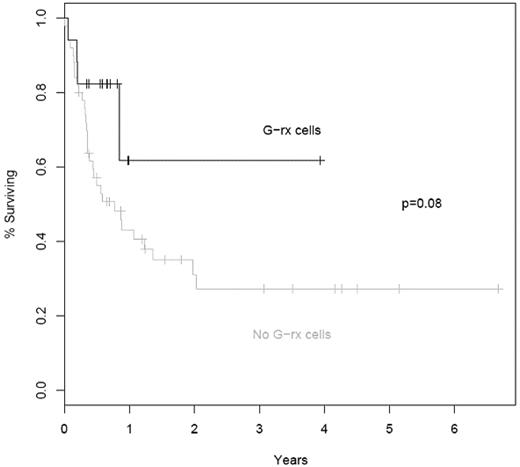Abstract
Abstract 4301
Donor lymphocyte infusions (DLI) can reverse relapse of hematologic malignancy following allogeneic hematopoietic stem cell transplant (HSCT) in some cases. G-CSF is used to mobilize progenitor cells for transplantation and at our center excess cells have been cryopreserved and subsequently used as DLIs. Little is known regarding the effectiveness of G-CSF mobilized cells as DLIs in the treatment of hematological malignancies. We conducted a retrospective study comparing the overall survival in patients treated with G-CSF mobilized vs. conventional DLI for hematological malignancies.
After IRB approval, we conducted a retrospective chart review of 67 patients who received DLI treatment of management of hematological malignancies.
Mean age was 48.5 (range 2-78). 41 (62%) patients had AML and 26 (38%) had other hematological malignancies. Patients received 1-4 DLIs each; median was 1 DLI per patient. Median no. of CD3+ cells infused was 107/kg body weight (range 1- 265). 17 (25%) patients received a total of 32 G-CSF mobilized DLIs. 50 (75%) patients received 77 conventional DLI. 20 (29%) patients were treated with immunosuppressive agents at the time of DLI and 49 (73%) received chemotherapy in the 90 days prior to DLI. DLIs were administered for relapse or residual disease post-transplant in 62 patients. 5 patients received 7 DLIs because of poor engraftment. In total 38(56%) patients have died. Death was malignant disease related in 31/38(82%) patients, and caused by graft versus host disease (GVHD) in 5/38 (13%). GVHD deaths were 2/17 in the G-CSF and 3/50 in the conventional group (NS). Median survival after DLI was 213 days for the 67 patients and was similar for GCSF and conventional groups. 19/67 patients survived more than 1 year from the initial DLI. Death and GVHD were not predicted by diagnosis, donor type (related of unrelated), use of immunosuppressives at the time and DLI or number of infused donor CD3 cells. Time to first evidence of GVHD was similar between the two groups (p=0.35). Kaplan-Meier estimates of survival suggested that G-CSF mobilized DLI, while not statistically different from conventional DLI, showed a trend towards a survival advantage (p=0.08). This analysis is shown in the figure below.
In this series of poor prognosis hematological malignancies, DLI was clearly lifesaving in a number of patients. G-CSF mobilized DLI appears to be at least as effective as conventional DLI for the treatment of patients relapsing after allogeneic blood stem cell transplantation.
No relevant conflicts of interest to declare.
Author notes
Asterisk with author names denotes non-ASH members.


This feature is available to Subscribers Only
Sign In or Create an Account Close Modal